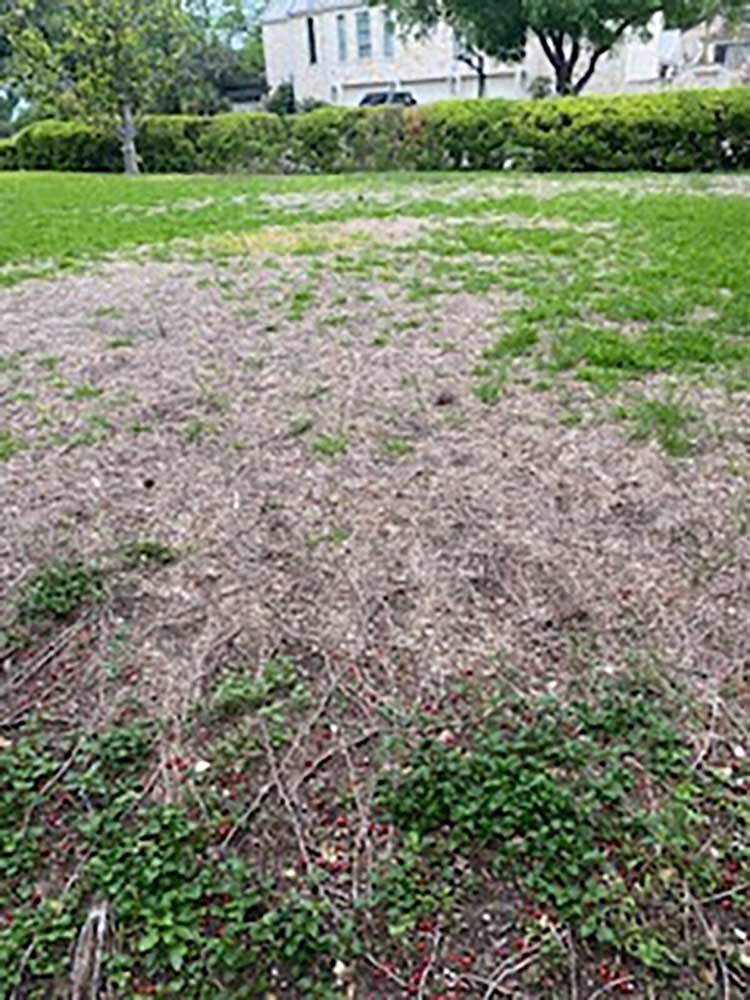Sperry: How to rid lawn of unwanted dichondra
Published 12:00 am Sunday, May 21, 2023

- St. Augustine with possible take-all root rot.
Dear Neil: What is this weed, and how can I get it out of my lawn? (I’m thinking it’s dichondra.)
Answer: Your assumption is correct. It’s actually a pretty little trailing weed that grows just an inch or two above the soil surface. Because of that, it’s difficult to get weedkiller spray down to it, but it can be done. Use a broadleafed weedkiller (containing 2,4-D) applied according to label directions and in a relatively fine mist spray. It helps to put one drop of liquid dishwashing detergent with each gallon of mixed spray to help hold it on the somewhat funnel-shaped leaves. Use a spray wand and not a hose-end sprayer for more precise applications and keep it off St. Augustine as much as you can just to avoid any possible damage to the turf now that it’s getting warmer. You could also use a trigger bottle applicator if you have only a tiny amount. It will take the 2,4-D a week or two to kill out the dichondra. During that time, you’ll see its growth become deformed. You may need a second application for any straggler plants a few weeks later. Rinse your spray tank carefully after you’re finished. Mark it and do not plan on using it for insecticides or fungicides in the future. It’s almost impossible to get rid of 2, 4-D residue.
Trending
Dear Neil: Our majestic live oaks have been struggling since the 2021 freeze and last summer’s drought. Now a hailstorm stripped off most of the leaves. What can we do to help it recover?
Answer: Only what you would do to keep it healthy and happy: Keep it watered deeply and regularly during summer dry spells and apply an all-nitrogen fertilizer with 25 percent to 40 percent of its nitrogen in slow-release form. Feed it now and again in late August.
Note: I have two questions that came in one after the other one day this week. Each pertains to St. Augustine, but they’re a little bit different. I thought I’d include them both so you could see how difficult it is to identify and differentiate the various St. Augustine issues.
Dear Neil: Your recent description of take-all root rot could have applied to my lawn. The runners pull up very easily, but I would not describe them as being “dark.” The lawn was great last June. We even had a wedding there, but now it’s really sad. Do you have any suggestions?
Answer: The runners in your photos have been dead long enough that their roots have decayed. You would want to examine runners right along the edges of the green and dead areas. If TARR is involved, that would give you a better idea of whether it’s present. It does not appear to be TARR to my eye. It looks more like leftover damage and loss from chinch bugs from late summer and fall. Please think back to how the grass looked in late August and September. If it was fine going into the winter then the damage could be from white grub worms or TARR, as they’re the two most common winter problems. For a modest fee, the Texas Plant Disease Clinic at Texas A&M in College Station could culture samples from runners and roots from a couple of those tufts of green grass sticking out from the right edge in your photo – the clumps that are slightly above the mid-point on the right side. At least that way you would know for sure.
Dear Neil: This is our daughter’s house in North Richland Hills. It was beautiful St. Augustine until late last summer. Their lawn care company said it was “root rot” and possibly chinch bugs. They treated for the chinch bugs and then with a fungicide for the dying St. Augustine. By spring, this is what they have left. Do they just need to cover it with topsoil and plant new grass? What other suggestions do you have?
Trending
Answer: To be this thorough, the damage almost has to have been caused by chinch bugs. All that’s left looks like bermudagrass. The Christmas cold spell, when temperatures dropped toward zero, did a lot of damage as well, but it sounds like this grass was already in trouble. Compare this lawn to the grass across the street. You can see the large, yellowed patches. That’s classic example of take all root rot. It’s a cool-season root disease of April and early May that lets up once it starts to get hot by late May. It should not have been hanging around in your daughter’s lawn in late summer and early fall.
Dear Neil: I have a Carolina jessamine vine growing on my wood fence. It has done very well for many years but now it’s only at the top of the fence, and all its ugly stems are showing. It also didn’t bloom very well this spring. Can I prune it back to make it look better? Can I still do that now?
Answer: You certainly can try cutting it back rather severely, reshaping it as you do. You’ll probably also see some new canes coming up from its base. Leave those in place to become the new stalks. Apply an all-nitrogen plant food, and water it deeply to promote strong new growth. If that doesn’t work as well as you expect, you may want to replace it with a new and vigorous plant. It seems like Caroline jessamine plants sometimes just wear out after 10 or 15 years, particularly when they’re grown in soils that are not perfectly to their liking. It’s easy enough just to plant another one.






